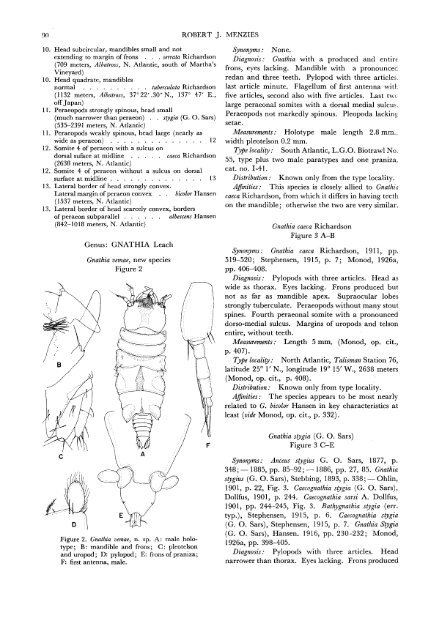The Isopods of Abyssal Depths in the Atlantic Ocean
The Isopods of Abyssal Depths in the Atlantic Ocean
The Isopods of Abyssal Depths in the Atlantic Ocean
You also want an ePaper? Increase the reach of your titles
YUMPU automatically turns print PDFs into web optimized ePapers that Google loves.
90<br />
ROBERT J. MRNZIES<br />
10. Head subcircular, mandibles small and not<br />
extend<strong>in</strong>g to marg<strong>in</strong> <strong>of</strong> frons . . . serrata Richardson<br />
(709 meters, Albatross, N. <strong>Atlantic</strong>, south <strong>of</strong> Martha's<br />
V<strong>in</strong>eyard)<br />
10. Head quadrate, mandibles<br />
normal tuberculata Richardson<br />
(1132 meters, Albatross, 37° 22'.30" N., 137° 47' E.,<br />
<strong>of</strong>f Japan)<br />
11. Peraeopods strongly sp<strong>in</strong>ous, head small<br />
(much narrower than peraeon) . . stygia (G. O. Sars)<br />
(535-2391 meters, N. <strong>Atlantic</strong>)<br />
11. Peraeopods weakly sp<strong>in</strong>ous, head large (nearly as<br />
wide as peraeon) 12<br />
12. Somite 4 <strong>of</strong> peraeon with a sulcus on<br />
dorsal suface at midl<strong>in</strong>e caeca Richardson<br />
(2638 meters, N. <strong>Atlantic</strong>)<br />
12. Somite 4 <strong>of</strong> peraeon without a sulcus on dorsal<br />
surface at midl<strong>in</strong>e 13<br />
13. Lateral border <strong>of</strong> head strongly convex.<br />
Lateral marg<strong>in</strong> <strong>of</strong> peraeon convex . . bicolor Hansen<br />
(1537 meters, N. <strong>Atlantic</strong>)<br />
13. Lateral border <strong>of</strong> head scarcely convex, borders<br />
<strong>of</strong> peraeon subparallel albescens Hansen<br />
(842-1018 meters, N. <strong>Atlantic</strong>)<br />
Genus: GNATHIA Leach<br />
Gnathia vemae, new species<br />
Figure 2<br />
Figure 2. Gnathia vemae, n. sp. A: male holotype;<br />
B: mandible and frons; C: pleotelson<br />
and uropod; D: pylopod; E: frons <strong>of</strong> praniza;<br />
F: first antenna, male.<br />
Synonyms: None.<br />
Diagnosis: Gnathia with a produced and entire<br />
frons, eyes lack<strong>in</strong>g. Mandible with a pronounced<br />
redan and three teeth. Pylopod with three articles,<br />
last article m<strong>in</strong>ute. Flagellum <strong>of</strong> first antenna with<br />
five articles, second also with five articles. Last two<br />
large peraeonal somites with a dorsal medial sulcus.<br />
Peraeopods not markedly sp<strong>in</strong>ous. Pleopoda lack<strong>in</strong>g<br />
setae.<br />
Measurements: Holotype male length 2.8 mm..<br />
width pleotelson 0.2 mm.<br />
Type locality: South <strong>Atlantic</strong>, L.G.O. Biotrawl No.<br />
55, type plus two male paratypes and one praniza.<br />
cat. no. 1-41.<br />
Distribution: Known only from <strong>the</strong> type locality.<br />
Aff<strong>in</strong>ities: This species is closely allied to Gnathia<br />
caeca Richardson, from which it differs <strong>in</strong> hav<strong>in</strong>g teeth<br />
on <strong>the</strong> mandible; o<strong>the</strong>rwise <strong>the</strong> two are very similar.<br />
Gnathia caeca Richardson<br />
Figure 3 A-B<br />
Synonyms: Gnathia caeca Richardson, 1911, pp.<br />
519-520; Stephensen, 1915, p. 7; Monod, 1926a,<br />
pp. 406-408.<br />
Diagnosis: Pylopods with three articles. Head as<br />
wide as thorax. Eyes lack<strong>in</strong>g. Frons produced but<br />
not as far as mandible apex. Supraocular lobes<br />
strongly tuberculate. Peraeopods without many stout<br />
sp<strong>in</strong>es. Fourth peraeonal somite with a pronounced<br />
dorso-medial sulcus. Marg<strong>in</strong>s <strong>of</strong> uropods and telson<br />
entire, without teeth.<br />
Measurements: Length 5 mm. (Monod, op. cit.,<br />
p. 407).<br />
Type locality: North <strong>Atlantic</strong>, Talisman Station 76,<br />
latitude 25° 1' N., longitude 19° 15' W., 2638 meters<br />
(Monod, op. cit., p. 408).<br />
Distribution: Known only from type locality.<br />
Aff<strong>in</strong>ities: <strong>The</strong> species appears to be most nearly<br />
related to G. bicolor Hansen <strong>in</strong> key characteristics at<br />
least [vide Monod, op. cit., p. 332).<br />
Gnathia stygia (G. O. Sars)<br />
Figure 3 C-E<br />
Synonyms: Anceus stygius G. O. Sars, 1877, p.<br />
348; — 1885, pp. 85-92; — 1886, pp. 27, 85. Gnathia<br />
stygius (G. O. Sars), Stebb<strong>in</strong>g, 1893, p. 338; —Ohl<strong>in</strong>,<br />
1901, p. 22, Fig. 3. Caecognathia stygia (G. O. Sars),<br />
Dollfus, 1901, p. 244. Caecognathia sarsi A. Dollfus,<br />
1901, pp. 244-245, Fig. 3. Bathygnathia stygia (err.<br />
typ.), Stephensen, 1915, p. 6. Caecognathia stygia<br />
(G. O. Sars), Stephensen, 1915, p. 7. Gnathia Stygia<br />
(G. O. Sars), Hansen. 1916, pp. 230-232; Monod,<br />
1926a, pp. 398-405.<br />
Diagnosis: Pylopods with three articles. Head<br />
narrower than thorax. Eyes lack<strong>in</strong>g. Frons produced

















